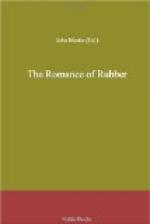So with Mother Nature’s perfection in doing things, the very plant juice that has done duty as a poison is hardened into an elastic stopper. with the result that, no matter how far the tree may sway and tug at the wound, the filling gives and stretches, true to the task it has to perform.
This was the juice the crafty savage induced the tree to give up. Wherever the bark was cut, the fluid poured forth to heal the break and hardened like blood on a cut finger. The native caught it while it was still soft and applied it to his simple needs.
This juice is not the sap of the rubber tree. Sap, which is the life-blood of the tree, flows through the wood, but the juice we are describing is contained in the inner bark, a thin layer directly below the outer bark.
Scientific men call this juice latex. It is like milk in three ways: it is white, it contains tiny particles that rise to the top like cream, and it spoils quickly.
The particles in cow’s milk are full of fats which make it good for us to drink. But a rubber tree’s milk has tiny atoms of rubber and resin and other things, and it took time to discover which of the vines and trees was the prize milker of the tropics and gave the largest amount of pure rubber. Finally, the Hevea, the very tree the Frenchman wrote about, proved to be the best, and, although by no means the only rubber tree of commercial value, it is acknowledged the greatest of rubber trees.
The Hevea tree grows sixty feet tall, and when full grown is eight or ten feet around. It rises as straight as an elm, with high branching limbs and long, smooth oval leaves. Sprays of pale flowers blossom upon it in August, followed in a few months by pods containing three speckled seeds which look like smooth, slightly flattened nutmegs. When the seeds are ready to drop the outer covering of the pod bursts with a loud report, the seeds shooting in all directions.
This is Nature’s clever scheme to spread the Hevea family. The tree grows wild in the hot, damp forests of the Amazon valley and in other parts of South America that have a similar climate. The ideal climate for the rubber tree is one which is uniform all the year round, from eighty-nine to ninety-four degrees at noon, and riot lower than seventy degrees at night. The Amazon country has a rainy season which lasts half the year, though the other season is by no means a dry one, and so for half the time the jungles are flooded.
These rubber storehouses had been growing for thousands of years in the Amazon jungle with their wealth securely sealed up in their bark, the peck of a bird, the boring of a beetle, or the scratch of a climbing animal being the only draft upon their treasure. The trees around the mouth of the river supplied whatever was needed for the little manufacturing that was at first done. But the discovery that made a universal use for rubber changed all this. Brazil was surprised to find what great treasure her forests contained. Large rubber areas were found a thousand miles up the river and she began in a serious way to develop a large crude rubber business.




